Aldehyde Ketones And Carboxylic Acid
Question 1. Write the structure of the following reactions:

Answer:

Question 2. Arrange the following compounds in the increasing order of their boiling points. CH3CHO, CH3CH2OH, CH3OCH3, CH3CH2CH3
Answer:

Question 3. Arrange the following compounds in increasing order of their reactivity in nucleophilic addition reactions.
- Enthanal, Propanal, Propanone,, Butanone,
- Benzaldehyde, p-Tolualdehyde, p-Nitrobenzaldehyde, Acetophenone.
Hint: Consider the steric effect and electronic effect.
Read and Learn More Class 12 Chemistry with Answers Chapter Wise
Answer: Reactivity of carbonyl compound α (+)ve change![]()

The +I effect of the alkyl group increases in the order:
Ethanal < Propanal < Propanone < Butanone
If the +I effect increases then (+)ve change on sp2 decreases.
So the reactivity order is: Butanone < Propanone < Propanal < Ethanal
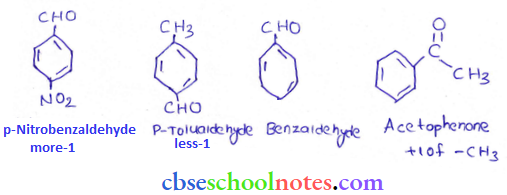
-I group on >C = O in reuses (+)ve charge so reactivity order is Acetophenone < p-tolualdchyde < Benzaldehvde < p-Nitrohenzaldehyde
Question 4. Predict the product of the following reactions:
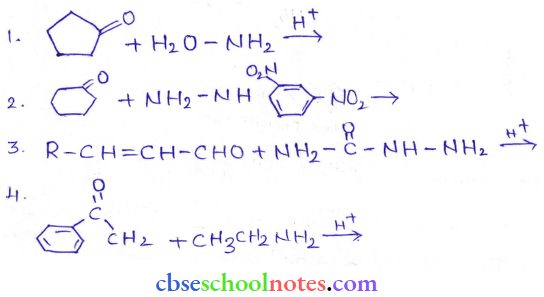
Answer:
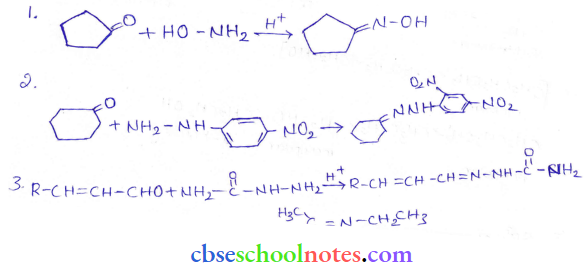

Question 5. Show how each of the following compounds can be converted to benzoic acid.
- Ethylbenzene
- Acetophenone
- Bromobenzene
- Phenylethane (Styrene)
Answer:


Question 6. Which of each pair shown here would you expect to be stronger?
- \(\mathrm{CH}_2 \mathrm{CO}_2 \mathrm{H}_2 \text { or } \mathrm{CH}_2 \mathrm{FCO}_2 \mathrm{H}\)
- \(\mathrm{CH}_2 \mathrm{FCO}_2 \mathrm{H} \text { or } \mathrm{CH}_2 \mathrm{ClCO}_2 \mathrm{H}\)
- \(\mathrm{CH}_2 \mathrm{FCH}_2 \mathrm{CH}_2 \mathrm{CO}_2 \mathrm{H} \text { or } \mathrm{CH}_3 \mathrm{CHFCH}_2 \mathrm{CO}_2 \mathrm{H}\)

Answer: Acidic Strength
- \(\mathrm{CH}_2 \mathrm{CO}_2 \mathrm{H}_2 \text { < } \mathrm{CH}_2 \mathrm{FCO}_2 \mathrm{H}\)
- \(\mathrm{CH}_2 \mathrm{FCO}_2 \mathrm{H} \text { > } \mathrm{CH}_2 \mathrm{ClCO}_2 \mathrm{H}\)
- \(\mathrm{CH}_2 \mathrm{FCH}_2 \mathrm{CH}_2 \mathrm{CO}_2 \mathrm{H} \text { < } \mathrm{CH}_3 \mathrm{CHFCH}_2 \mathrm{CO}_2 \mathrm{H}\)

Question 7. Give names of the reagents to bring about the following transformations:
- Hexan-1-ol to hexanal
- Cyclohexanol to cyclohexanone
- p-FluorotoIuene to p-fluorobenzaldchydc
- Ethanenitrile to ethanal
- Allyl alcohol to propenal
- But-2-ene to ethanal
Answer:
- C5H5NH+CrO3Cl(PCC)
- K2Cr2O7 in an acidic medium
- CrO in the presence of acetic anhydride 1. CrO2Cl2 2. HOH
- (Diisobutyl) aluminium hydride (DIBAL-H)
- PCC
- O3/H2O-Zn dust
Question 8. Arrange the following compounds in the increasing order of their boiling points:
⇒\(\mathrm{CH}_3 \mathrm{CH}_2 \mathrm{CH}_2 \mathrm{CHO}, \mathrm{CH}_3 \mathrm{CH}_2 \mathrm{CH}_2 \mathrm{CH}_2 \mathrm{OH}, \mathrm{H}_5 \mathrm{C}_2-\mathrm{O}-\mathrm{C}_2 \mathrm{H}_3, \mathrm{CH}_3 \mathrm{CH}_2 \mathrm{CH}_2 \mathrm{CH}_2 \mathrm{CH}_3\)
Answer:
- The molecular masses of these compounds are in the range of 72 to 74. Since only butane-1-ol molecules are associated due to extensive intermolecular hydrogen bonding, therefore, the boiling point of butan-1-ol would be the highest.
- Butanal is more polar than ethoxyethane. Therefore, the intermolecular dipole-dipole attraction is stronger in the former, n-Pentane molecules have only weak van der Waals forces. Hence increasing order of boiling points of the given compounds is as follows :
⇒\(\mathrm{CH}_2 \mathrm{CH}_2 \mathrm{CH}_2 \mathrm{CH}_2 \mathrm{CH}_3<\mathrm{H}_3 \mathrm{C}_2-\mathrm{O}-\mathrm{C}_2 \mathrm{H}_5\)<\(\mathrm{CH}_2 \mathrm{CH}_2 \mathrm{CH}_2 \mathrm{CHO}<\mathrm{CH}_3 \mathrm{CH}_2 \mathrm{CH}_2 \mathrm{CH}_2 \mathrm{OH}\)
Question 9. Would you expect benzaldehyde to be more reactive or less reactive in nucleophilic addition reactions than propanal? Explain your answer.
Answer:
The carbon atom of the carbonyl group of benzaldehyde is less electrophilic than the carbon atom of the carbonyl group present in propanal. The polarity of the carbonyl group is reduced in benzaldehyde due to resonance as shown below and hence it is less reactive than propanal.
Question 10. An organic compound (A) with molecular formula CsHsO forms an orange-red precipitate with 2,4-DNP reagent and gives a yellow precipitate on heating with iodine in the presence of sodium hydroxide. It neither reduces Tollens’ or Foldings’ reagent nor does it decolourise bromine water or Baeyer’s reagent. On drastic oxidation with chromic acid, it gives a carboxylic acid (B) having molecular formula C7H6O2. Identify the compounds (A) and (B) and explain the reactions involved.
Answer:
(A)forms 2,4-DNP derivative. Therefore, it is an aldehyde or a ketone. Since it does not reduce Tollens’ or Fehling reagent, (A) must be a ketone. (A) responds to the iodoform test. Therefore, it should be a methyl ketone.
- The molecular formula of (A) indicates a high degree of unsaturation, yet it does not decolourise bromine water or Baeyer’s reagent.
- This indicates the presence of unsaturation due to an aromatic ring. Compound (B), being an oxidation product of a ketone should be a carboxylic acid.
- The molecular formula of (B) indicates that it should be benzoic acid and compound (A) should, therefore, be a monosubstituted aromatic methyl ketone. The molecular formula of (A) indicates that it should be phenyl methyl ketone (acetophenone). Reactions are as follows:

Question 11. Write chemical reactions to affect the following transformations:
- Butan-1-ol to butanoic acid
- Benzyl alcohol to phenylethanoid acid
- 3-Nilrobromobenzene to 3-nitrobenzoic acid
- 4-Methylacetophenone to benzene-1,4-dicarboxylic acid
- Cyelohexene to hexane-1,6-dioic acid
- Butanal to butanoic acid.
Answer:

Question 12. What is meant by the following terms? Give an example of the reaction in each case.
- Cyanohydrin
- Acetal
- Semicarbazone
- Aldol
- Hemiacetal
- Oxime
- Ketal
- Inline
- 2,4- DNP-derivative
- Schiffs base
Answer: Cyanohydrin: The organic compounds have -CN and -OH groups in the structure.
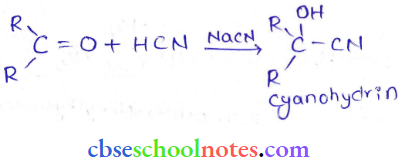
Acetal: Acetals are gem-dial koxy alkanes in which two alkoxy groups are present on the terminal carbon atom.

Semicarbazone: Semicarbazone,s are derivatives of aldehydes and ketones produced by the condensation reaction between a ketone or aldehyde and semicarbazide.

Aldol: A β-hydroxy aldehyde or ketone is known as an aldol. It is produced by the condensation reaction of two molecules of the same or one molecule each of two different aldehydes or ketones with aH in the presence of a base.

Hemiacetal: Hemiacetal are a-alkoxyalcohols Aldehyde reacts with one molecule of a monohydric alcohol in the presence of dry HCl gas.
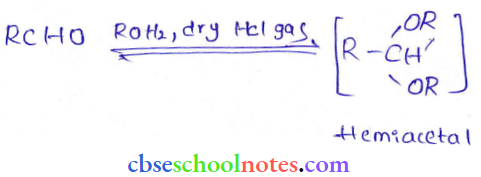
Oxime: Oximes are a class of organic compounds having a general formula.

On treatment with hydroxyl amine in a weakly acidic medium, aldehydes or ketones form oximes.

Ketal: Ketals are gem-dialkoxyalkanes in which two alkoxy groups are present on the same carbon atom within the chain.

Imine:
![]() Iminces Imines are produced when aldehydes and ketones react with R- NH2.
Iminces Imines are produced when aldehydes and ketones react with R- NH2.

2, 4-DNP-derivative: 2, 4-dinitrophenyIhydrazones are 2, 4-DNP-derivatives, which are produced when aldehydes or ketones react with 2. 4-dinitrophenylhydrazine in a weakly acidic medium.

To identify and characterize aldehydes and ketones, 2, 4-DNP derivatives are used.
Sehiffs Base: Is >c = NR (R is not Hydrogen) (R may be -Ph)
Aldehydes and ketones on treatment with primary aliphatic or aromatic amines in the presence of a trace of an acid yield a Schiffs base.

Question 13. Draw structures of the following derivatives.
- The 2, 4-dinitrophenylhydrazone of benzaldehyde
- Cyclopropane oxime
- Acctaldehydedimcthylacctal
- The semicarbazone of cyclobutanone
- The ethylene ketal of hexane-3-one
- The methyl hemiacetal of formaldehyde
Answer:

Question 14. Predict the products formed when cyclohexanecarbaldehyde reacts with the following reagents.
- PhMgBr and then H3O+
- Tollen’s reagent
- Semicarbazide and weak acid
- Excess ethanol and acid
- Zinc amalgam and dilute hydrochloric acid
Answer:
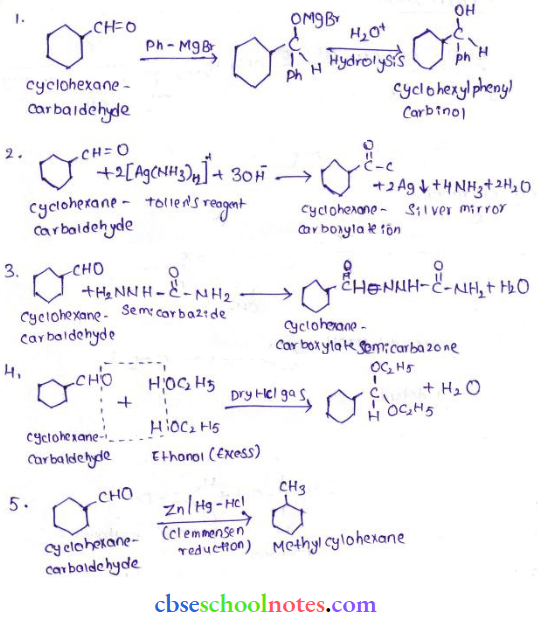
Question 15. Which of the following compounds would undergo aldol condensation, which is the Cannizzaro reaction and which neither? Write the structures of the expected products of aldol condensation and Cannizzaro reaction.
- Methanal
- 2-Methylpentanal
- Benzaldehyde
- Benzophenone
- Cyclohexanone
- 1-Phenylpropanone
- Phenylacetaldehyde
- Bulan-1-ol
- 2,2-Dimethylbutanal
Answer: Aldehydes and ketones having at least one a-hydrogen undergo aldol condensation (2), (5), (6), and (7) give aldol condensation.
- Aldehydes (only) having no a-hydrogen undergo Cannizzaro reactions, (1), (3), (9) give Cannizzaro reaction.
- Compound (4) is a ketone having no a-hydrogen atom and compound (8) Bulan-l-ol is an alcohol. Hence, these compounds do not undergo either aldol condensation or Cannizzaro reactions.
Aldol condensation:
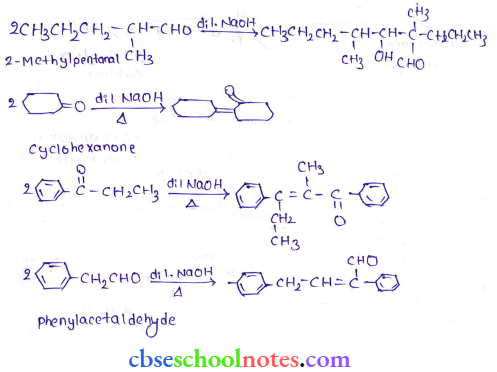
Cannizaro Reaction:
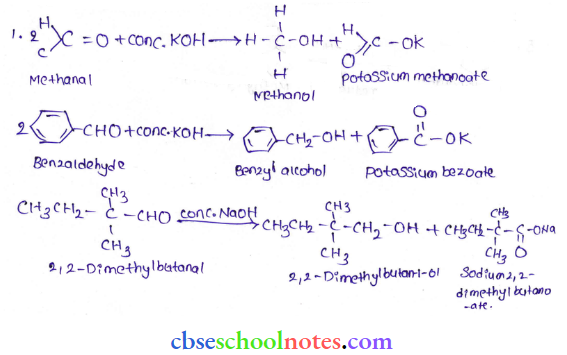
Question 16. How will you convert cthanal into the following compounds?
- Butane-1,3-diol
- But-2-enal
- But-2-enoic acid
Answer:
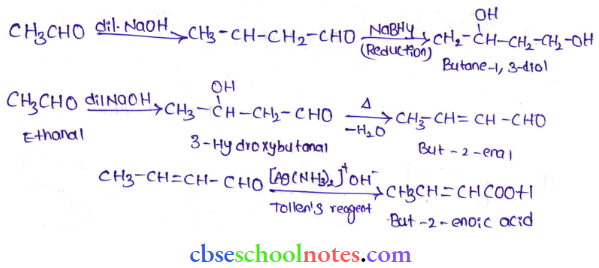
When treated with Tollen’s reagent, But-2-enal produced in the above reaction produces but-2-enoic acid.
Question 17. Write structural formulas and names of four possible aids from propanal and butanal. In each case, indicate which aldehyde acts as a nucleophile and which is an electrophile.
Answer:
Take two molecules of propanal. one which acts as a nucleophile and the other as an electrophile.

Taking two molecules of butanal. one which acts as a nucleophile and the other as an electrophile.

Take one molecule each of propanal and butanal in which propanal acts as a nucleophile and butanal act as an electrophile.

Taking one molecule each of propanal and butanal in which propanal acts as an electrophile and butanal acts as a nucleophile.

Question 18. An organic compound (A) (molecular formula (C8H16O2) was hydrolysed with dilute sulphuric acid to give a carboxylic acid (B) and an alcohol (C). Oxidation of (C) with chromic acid produced (B). (C) on dehydration gives but-1-cue. Write equations for the reactions involved.
Answer: Hydrolysis of ester gives acid and alcohol


Question 19. Arrange the following compounds in increasing order of their property as indicated:
Acetaldehyde, Acetone, Di-tert-butyl ketone. Methyl tert-butyl ketone
⇒ \(\mathrm{CH}_3\mathrm{CH}_2\mathrm{CH}(\mathrm{Br})\mathrm{COOH}\), \(\mathrm{CH}_3\mathrm{CH}(\mathrm{Br})\mathrm{CH}_2\mathrm{COOH},\left(\mathrm{CH}_3\right)_2\mathrm{CHCOOH},\mathrm{CH}_3 \mathrm{CH}_2\mathrm{CH}_2\mathrm{COOH}\)
Benzoic acid, 4-Nitrobenzoic acid, 3,4-Dinitrobenzoic acid, 4-Methoxybenzoic acid
⇒ \(\mathrm{CH}_3 \mathrm{COCl}, \mathrm{CH}_3 \mathrm{CONH}_2, \mathrm{CH}_3 \mathrm{COOCH}_3,\left(\mathrm{CH}_3 \mathrm{CO}\right)_2 \mathrm{O}\)
Answer: Di-tert-butyl ketone < Methyl tert-butyl ketone < Acetone < Acetaldehyde
![]()
4-Methoxybezo
Question 20. Give simple chemical tests to distinguish between the following pairs of compounds.
- Propanal and Propanonc
- Acetophenone and Bcnzophenonc
- Phenol and Benzoic acid
- Benzoic acid and Ethyl benzoate
- Pentan-2-one and Pentan-3-one
- Benzaldehyde and Acetophenone
- Ethanal And Propanal
Answer: 1. By Tollen’s test
Propanal reduces Tollen’s reagent, Fehling solution, and Benedict solution but propanonc (ketone) does not. reduces. Iodoform test: Propanone gives an iodoform test but propanal (CH3-CH2-CHO) does not.
2. Acetophenone and Benzophenone can be distinguished using the iodoform test. Acetophenone gives an iodoform test but benzophenone does not.
3. Phenol and benzoic acid can be distinguished by the ferric chloride test and NaHCO3, test.
- Phenol gives a violet colour with FeCl3,
- Benzoic acid gives CO2 with NaHCO3 while phenol does not.
4. Benzoic acid and Ethyl benzoate can be distinguished by the sodium bicarbonate test. Sodium bicarbonate test: Benzoic acid reacts with NaHCO3 to produce brisk effervescence due to the evolution of CO2 gas but ethylbenzoate does not.
5. Pentan-2-one and pentan-3-one can be distinguished by iodoform lest. Pentan-2-one gives an iodoform test but pentan-3-one does not.
6. Benzaldehyde and acetophenone can be distinguished by (1) Tollen’s test and (2) the Iodoform test. Benzaldehyde gives Tollen’s test whereas acetophenone gives an iodoform test.
7. Ethanal and propanal can be distinguished by the iodoform test. Ethanal gives an iodoform test but propanal does not.
Question 21. How will you prepare the following compounds from benzene? You may use any inorganic reagent and any organic regent having not more than one carbon atom
- Methoxybenzoic
- M-Nitrobenzoic acid
- P-Nitrobenzoic acid
- Phenylacetic acid
- P-Nitrobenzaldehyde
Answer:
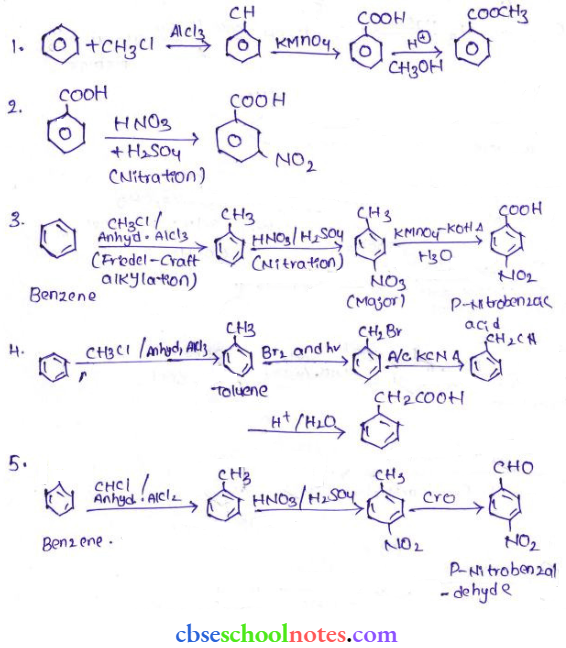
Question 22. How will you about the following conversions in more than two steps?
- Propanone to Propene
- Benzoic acid to Benzaldehyde
- Ethanol to 3-Hydroxybutyanal
- Benzene to m- Nitroacetophenone
- Benzaldehyde to Benzophenone
- Bromobenze to 1-Phenylethanol
- Benzaldehyde to 3-Phenylpropan-1-ol
- Benzaldehyde to α-Hydroxyphenylacetic acid
Answer:
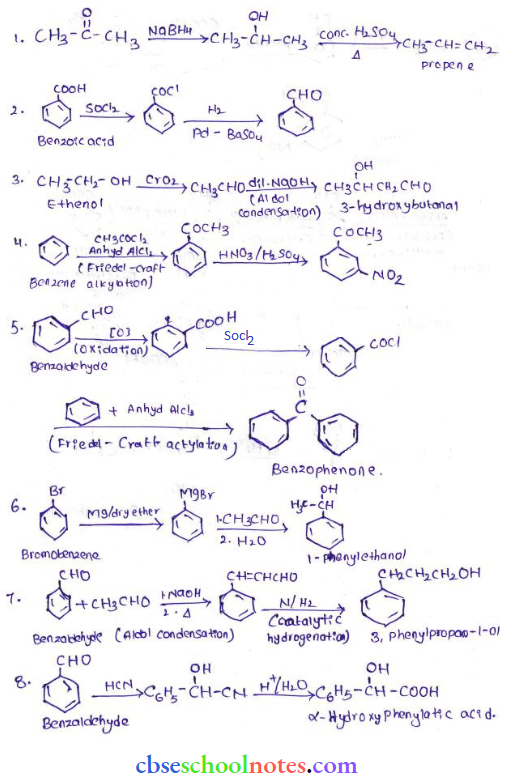
Question 23. Describe the following:
- Acetylation
- Carnnizzaro reaction
- Cross aldol condensation
- Decarboxylation
Answer: Acetylation: To introduce acetyl group in an organic compound.
in an organic compound.

Carnnizzaro reaction: The self-oxidation-reduction (disproportionation) reaction of aldehydes having no ex-hydrogens on treatment with concentrated alkalis is known as the Cannizzaro reaction. In this reaction, two molecules of aldehydes participate where one is reduced to alcohol and the other is oxidized to carboxylic acid.

Cross-aldol condensation: The reaction between two different aldehydes, or two different ketones, or an aldehyde and a ketone (having α-H) in the presence of a base is called a cross-aldol condensation.
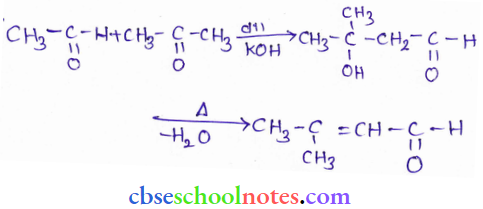
Decarboxylation: Decarboxylation refers to the reaction in which carboxylic acids lose carbon dioxide to form hydrocarbons when their sodium salts are heated with soda-lime.

Question 24. Complete each synthesis by giving missing starting material, reagent or products.
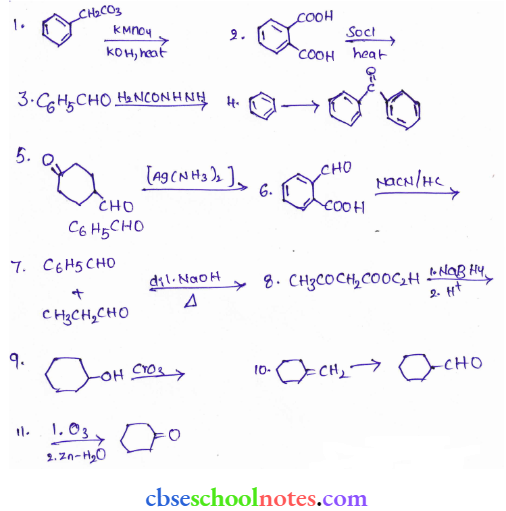
Answer:
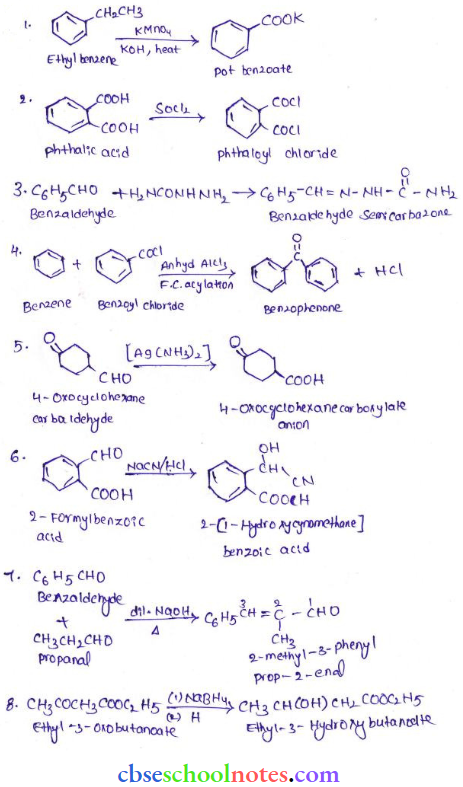
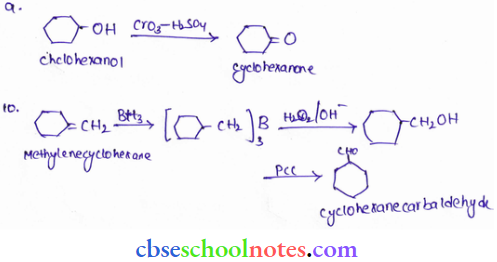

Question 25. Give a plausible explanation for each of the following:
- Cyclohexanone forms cyanohydrin in good yield but 2, 2, 6-trimethyl cyclohexanone does not.
- There are two, groups in semicarbazide. However, only one is involved in the formation of semicarbazone.
- During the preparation of esters, a carboxylic acid and an alcohol in the presence of an acid catalyst, the water or the ester should be removed as soon as it is formed.
Answer: Cyclohexanones form cyanohydrins according to the following equation.
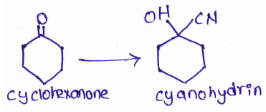
In 2, 2. 6 – trimethyl cyclohexanone, methyl groups at α-positions offer steric hindrance and as a result.
CN– cannot attack effectively.

2, 2, 6 – trimethyl cyclohexanone,
For this reason, it does not form a cyanohydrin.
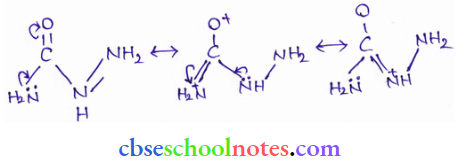
The electron density on the -NH2, group involved in the resonance also decreases. As a result, it cannot act as a nucleophile. Since the other -NH2, the group is not involved in resonance: it can act as a nucleophile and can attack carbonyl – carbon atoms of aldehydes and ketones to produce semicarbazone.

If either water or ester is not removed as soon as it is formed, then it reacts to give back the reactants as the reaction is reversible.
Question 26. An organic compound contains 69.77% carbon. 11.63% hydrogen and the rest oxygen. The molecular mass of the compound is 86. It does not reduce Tollen’s reagent but forms an additional compound with sodium hydrogen sulphite and gives a positive iodoform test. On vigorous oxidation, it gives ethanoic and propanoic acid. Write the possible structure of the compound.
Answer:
% of carbon = 69.77%
% of hydrogen = 11.63%
% of oxygen = [100-(69.77 + 11.63)]% = 18.6%
Thus, the ratio of the number of carbon, hydrogen and oxygen atoms in the organic compound can be given as:
⇒ \(\mathrm{C}: \mathrm{H}: \mathrm{O}=\frac{69.77}{12}: \frac{11.63}{1}: \frac{18.6}{16}=5.81: 11.63: 1.16=5: 10: 1\)
Therefore, the empirical formula of the compound is C5H10O. Now, the empirical formula mass of the compound can be given as:
5 × 12 +10 × 1 + 1 × 16 = 86
Molecular mass of the compound = 86 (given)
Therefore, the molecular formula of the compound is given by C5H10O.
Since the given compound does not reduce Tollen’s reagent, it is not an aldehyde. Again the compound forms sodium hydrogen sulphate addition products and gives a positive iodoform test. Since the compound is not an aldehyde, it must be a methyl ketone.
The given compound also gives a mixture of ethanoic acid and propanoic acid.
Hence, the given compound is plan-2-one.

The given reactions can be explained by the following equations:

Question 27. Although phenoxide ion has more number of resonating structures than carboxylate ion. carboxylic acid is a stronger acid than phenol. Why?
Answer: Resonance structures of phenoxide ion are:
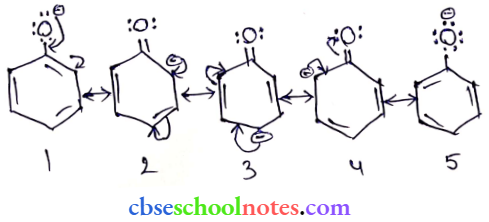
Unequivalent resonating structures

Equivalent resonating structures are more stable.
